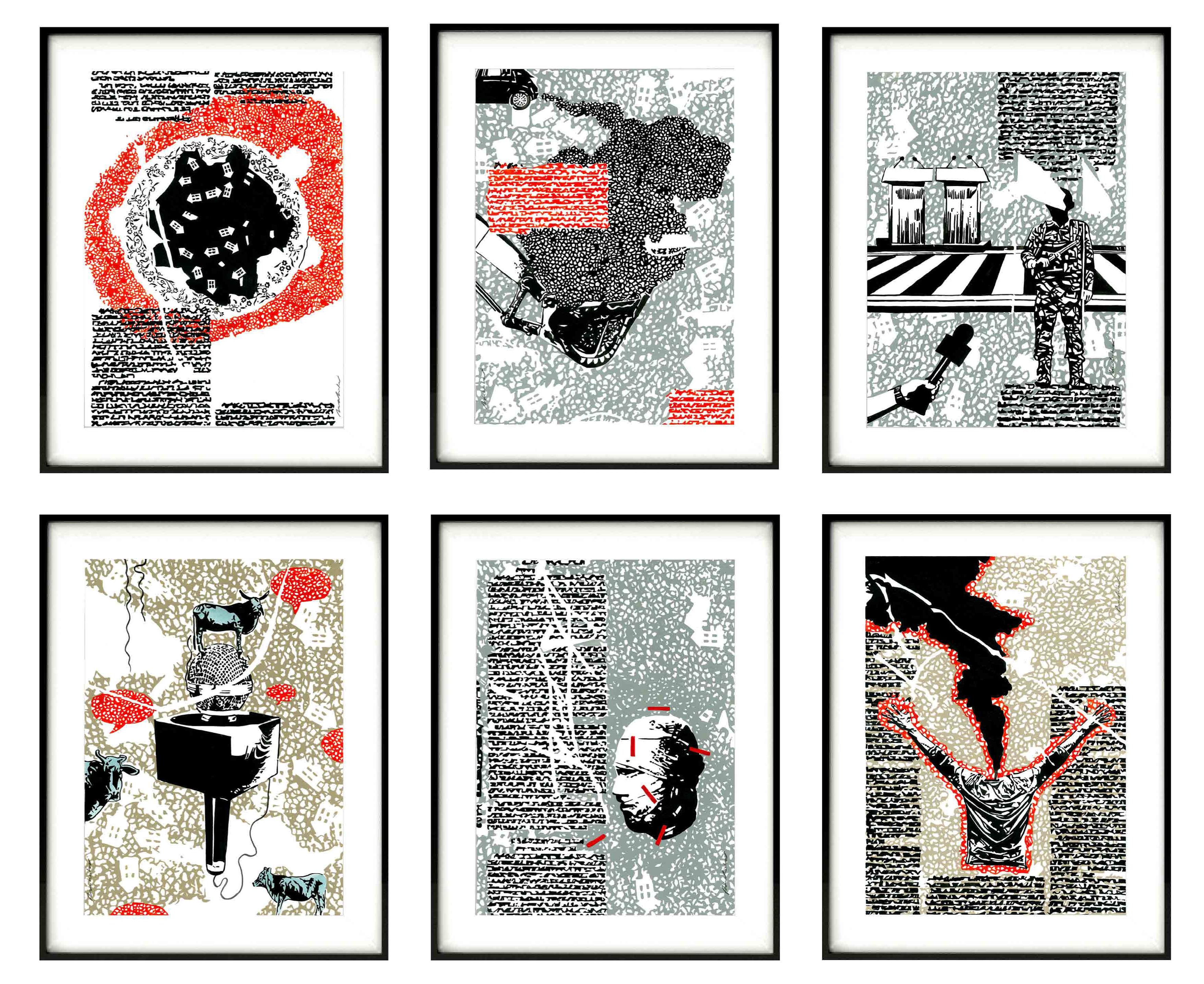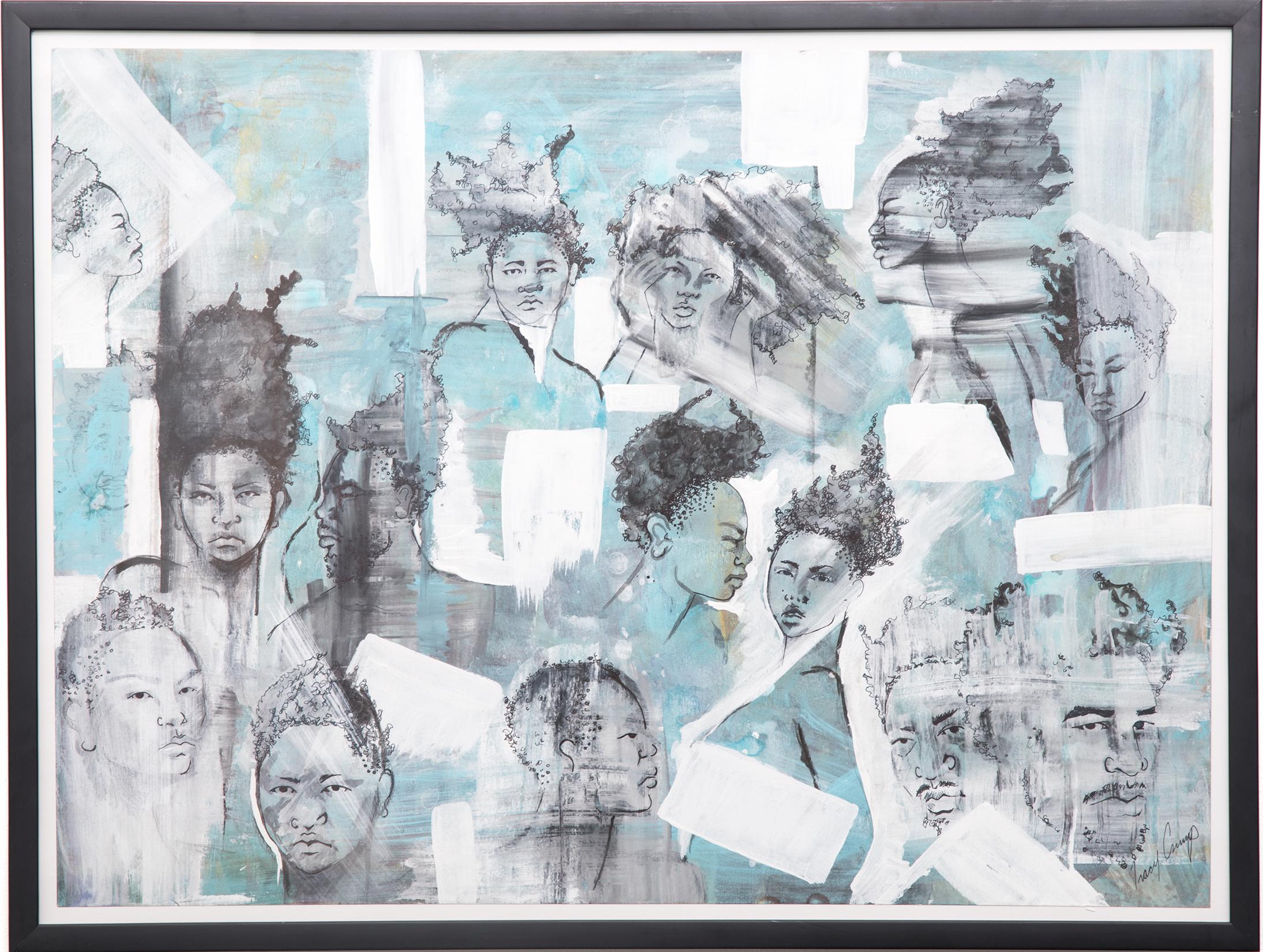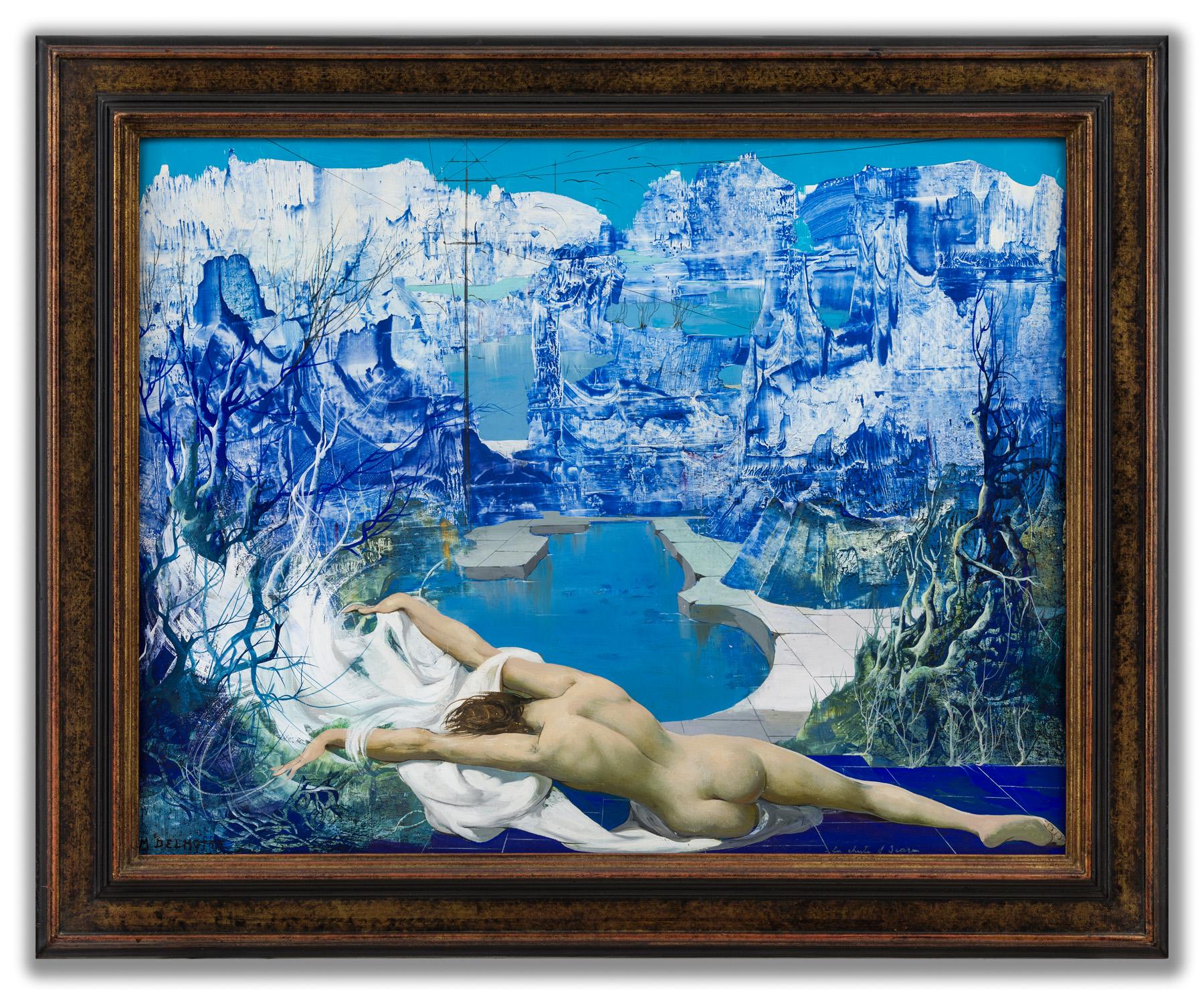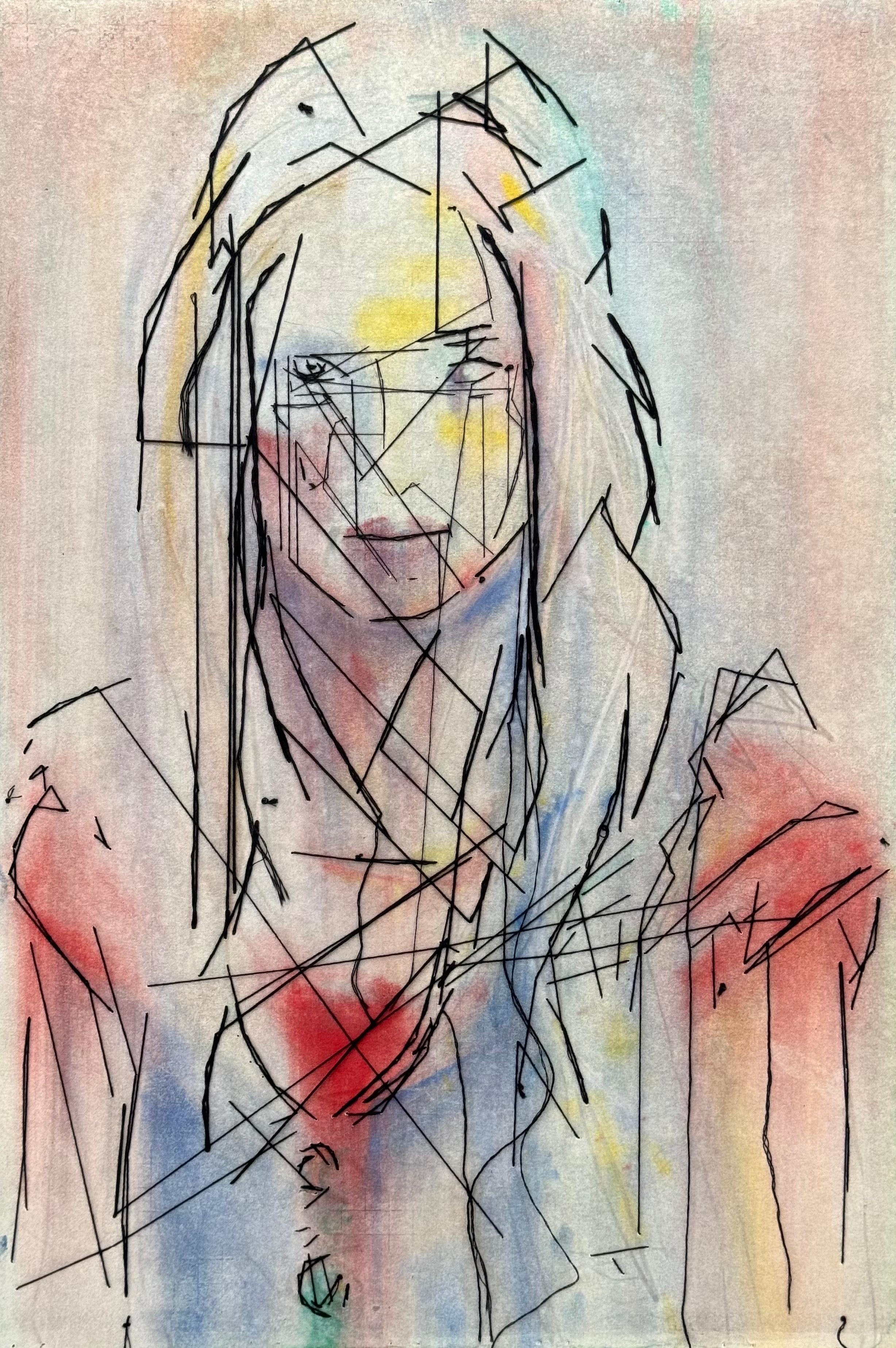Items Similar to "Amina and Sigmund" Double Portrait, Abstract Expressionist Female, Watercolor
Want more images or videos?
Request additional images or videos from the seller
1 of 5
Grace Hartigan"Amina and Sigmund" Double Portrait, Abstract Expressionist Female, Watercolor1986
1986
About the Item
Grace Hartigan
Amina and Sigmund, 1986
Signed and dated lower right
Watercolor on paper
84 x 60 inches
Grace Hartigan’s career began among the New York School artists of the 1940s and 1950s after she left her birthplace of Newark, NJ where she studied mechanical drafting as well as painting under Isaac Lane Muse. She befriended and was accepted among established Abstract Expressionists such as Jackson Pollock, Willem de Kooning, Larry Rivers, and poet Frank O’Hara. While she subscribed to the popular mode of painterly expression and the visibility of the artist’s hand, her work extends beyond the individual. Her later works employ both popular culture and art historical references (Hartigan made a conscious decision in 1952 to paint studies after the Old Masters) in a way that helped her paintings resonate with contemporary American life, particularly that of her own locale in the East Village. For Hartigan, abstraction and figuration were not mutually exclusive; pictorial structures in her work are vehicles for emotion, and are handled in a painterly, expressionist manner.
It is for her bold stylistic experimentation that Hartigan is best known. Her brushstrokes are gestural, exude a sense of urgency, and create dramatic lines filled with washes of opulent color, culminating in lyric compositions that dance across the surface of the canvas. Her works from the 1960s take an organic, curvilinear form, while later works from the 1970s are distinctly more figural, showcasing a collection of invented symbols reflecting her interest in mythological subjects.
During the 1950s the Tibor de Nagy Gallery, a spot known as a salon of sorts for the New York School, hosted seven solo exhibitions of Hartigan’s work. She was selected in 1950 for the New Talent exhibition organized by influential critics Clement Greenberg and Meyer Schapiro at another prominent mid-century gallery, the Samuel Kootz Gallery. She was the only woman artist included in The Museum of Modern Art’s international exhibition The New American Painting, which traveled from New York City across Europe between 1958 and 1959. Her paintings and biography were additionally featured in Life magazine and Newsweek at the end of the decade.
A rejection of Abstract Expressionism and the subsequent shift in favor toward Pop and Minimalist styles during the 1960s motivated Hartigan to seek out what she considered to be a less creatively limiting environment. She relocated to Baltimore, Maryland where her career only continued to thrive. She was appointed Director of the Graduate Hoffberger School of Painting at the Maryland Institute College of Art, and gained representation by the C. Grimaldis Gallery, which remains her primary representation after her death in 2008. Six colleges and universities across Maryland and Pennsylvania selected Hartigan to receive honorary degrees. She is also the recipient of numerous additional awards and honors including the Lifetime Achievement Award (Neuberger Museum, 2002) and the Governor’s Award (Baltimore, MA 2006).
Hartigan’s legacy is significant not only in her contribution to the development of American painting, but also as an example of a strong and independent female influence on the mid-century New York art scene. Her career allows art historians today the opportunity to reconsider a generation and artistic era often defined in narrow, patriarchal terms. Her talent did not go unrecognized despite the overwhelming attention given to her male contemporaries. She was able to embrace and contribute to the evolution of Abstract Expressionism while also maintaining a sense of what distinguished her oeuvre, ultimately positioning it to remain relevant in the latter decades of the twentieth century. Her re-introduction of figurative representation, interpreted in a painterly manner rather than necessarily striving for an antiquated sense of realism, paved the way for the New Figuration and Neo-Expressionist artists of the 1970s and 1980s.
- Creator:Grace Hartigan (1922-2008, American)
- Creation Year:1986
- Dimensions:Height: 87 in (220.98 cm)Width: 63 in (160.02 cm)
- More Editions & Sizes:Unique workPrice: $45,000
- Medium:
- Period:
- Framing:Framing Options Available
- Condition:
- Gallery Location:New York, NY
- Reference Number:1stDibs: LU1841214454492
About the Seller
5.0
Platinum Seller
These expertly vetted sellers are 1stDibs' most experienced sellers and are rated highest by our customers.
Established in 2021
1stDibs seller since 2022
63 sales on 1stDibs
Typical response time: <1 hour
- ShippingRetrieving quote...Ships From: New York, NY
- Return PolicyA return for this item may be initiated within 3 days of delivery.
More From This SellerView All
- "Portrait of an Italian Fencer, " John Frederick Kensett, Hudson River SchoolBy John Frederick KensettLocated in New York, NYJohn Frederick Kensett (1816 - 1872) Portrait of an Italian Fencer, circa 1845-47 Watercolor on wove paper 13 1/8 x 8 1/8 inches Signed with initials and inscribed lower right "J.F.K. Rome" From October 1845 through the spring of 1847, Kensett lived in Rome. He attended classes where he sketched from live models, and he sketched in the countryside outside Rome and around Florence, Perugia, and Venice, places he visited with his artist friends. He fulfilled commissions for paintings from Americans in Italy, and by 1847 his career was well established. Son of an English immigrant engraver, John Kensett lacked enthusiasm for that medium and became one of the most accomplished painters of the second generation of Hudson River School painters. His reputation is for Luminism, careful depiction of light, weather, and atmosphere as they affect color and texture of natural forms. He was particularly influenced by the painting of Asher Durand in that he focused on realism and detail rather than the highly dramatic views associated with Thomas Cole. Going to the western United States in the mid 1850s and the 1860s, he was the first of the Hudson River School painters to explore and paint the West. Kensett was born and raised in Cheshire, Connecticut, and learned his engraving from his father, Thomas Kensett with whom he worked in New Haven, Connecticut until 1829. He continued working until 1840 as an engraver of labels, banknotes and maps and was employed part of that time by the American Bank Note Company in New York City. There he met Thomas Rossiter, John Casilear, and other artists who urged him to pursue painting. In 1840, he and Rossiter, Asher Durand, and Casilear went to Europe where Kensett stayed for seven years and supported himself by doing engraving but became accomplished in landscape painting. Having sent canvases of Italian landscapes back to New York, he had a reputation for skillful painting that preceded him. When he returned to New York City in 1847, he was an "instant success" and very sought after by collectors. Two of his Italian landscapes had already been purchased by the American Art Union. By 1849, he was a full member of the National Academy of Design and was generally popular among his peers. His studio was a gathering place with travelers stopping by to see his canvases and to identify "precise locations in the Catskills or Newport or New England in the oil sketches and drawings that covered his walls." (Zellman 170). For the women, he was a popular bachelor, "romantic looking with high forehead and sensitive expression." (Samuels 262) He was also sought after by many organizations. Among his activities were serving on the committee to oversee the decoration of the United States Capitol in Washington DC, and becoming one of the founders of the Metropolitan Museum in New York. An inveterate traveler, Kensett spent summers on painting excursions away from New York City. One of these trips was a special painting excursion with fifteen other artists sponsored by the B & O Railroad from Baltimore, Maryland to Wheeling, West Virginia. Unlike many of the Hudson River painters...Category
1840s Hudson River School Figurative Paintings
MaterialsWatercolor, Paper
- "Teenagers, Coney Island" Outdoor Scene, Figures in Landscape, Beach, New YorkBy Philip ReismanLocated in New York, NYPhilip Reisman Teenagers, Coney Island Signed lower left Watercolor on paper 12 3/4 x 10 3/4 inches When he was four years old, Reisman fled Polish pogroms with his mother and thre...Category
20th Century Realist Figurative Paintings
MaterialsPaper, Watercolor
- "Zapotecan" Marion Greenwood, Indigenous Mexican Figurative WatercolorBy Marion GreenwoodLocated in New York, NYMarion Greenwood Zapotecan, 1956 Signed and dated Watercolor on paper 12 1/4 x 9 5/8 inches Provenance: Milch Galleries, New York Marion Greenwood, a painter and printmaker, was bo...Category
1950s Figurative Drawings and Watercolors
MaterialsPaper, Watercolor
- "Flower Girl, " John George Brown, Genre Painting, Street FigureBy John George BrownLocated in New York, NYJohn George Brown (1831 - 1913) Flower Girl, circa 1900 Watercolor on paper 6 3/4 x 4 3/4 inches Signed lower left Period Hand Carved Foster Brothers Fram...Category
Early 1900s Ashcan School Figurative Paintings
MaterialsPaper, Watercolor
- "Pleased to See You, " Crash, Pop Art, Street Art GraffitiBy John Crash MatosLocated in New York, NYCrash Pleased to See You, 1989 Signed and dated lower left Watercolor and ink on paper 30 x 20 1/2 inches A contemporary of Keith Haring and a modern-day master of this present day ...Category
1980s Street Art Figurative Paintings
MaterialsInk, Watercolor, Paper
- "Untitled" Bob Thompson, Figurative Work on Paper, Black Abstract ArtistBy Bob ThompsonLocated in New York, NYBob Thompson Untitled, 1964 Felt tip pen on printed paper 11 x 20 1/2 inches Provenance: The artist Kathy Komaroff Goodman (gift from the artist) Hollis Taggart, New York Exhibited...Category
1960s Modern Figurative Drawings and Watercolors
MaterialsWatercolor, Paper
You May Also Like
- Bites of Trivial Matter- Painting By Indian Artist in Red + Black on PaperBy Binay SinhaLocated in Gilroy, CA"Bites of Trivial Matter," is a six panel work by Binay Sinha. The artist discusses modernity, specifically the effect in has on an urban society. The transition from small communi...Category
2010s Contemporary Figurative Paintings
MaterialsAcrylic, Watercolor, Handmade Paper
- Robert Andrew Parker Watercolor "Seated Figure #2" Partially Nude FemaleBy Robert Andrew ParkerLocated in Detroit, MI"Seated Figure #2" is distinctly vibrant and sexual with a feminine-mystique glow in this stunning example of Robert Parker's Expressionist watercolor. The blue, pink and black creates a brilliant exploding power that engages the viewer immediately leading to the gorgeously rendered partially nude...Category
Late 20th Century Expressionist Figurative Paintings
MaterialsPaper, Watercolor
- 'The People People 2, " Acrylic Paint on Canvas, 2006Located in Chicago, ILIn this series entitled "The People People," Tracy Crump uses washes of grey, white and aqua to both conceal and reveal sensitively drawn figures. Each figure stands alone as an indi...Category
21st Century and Contemporary Outsider Art Figurative Drawings and Water...
MaterialsPaper, Ink, Acrylic, Watercolor
- Sisters By SoulBy Martina NiederhauserLocated in Los Angeles, CAInternationally acclaimed artist Martina Niederhauser presents a new collection that offers fresh perspectives on women, delving into the realms of emotion, beauty, identity, and the...Category
21st Century and Contemporary Contemporary Figurative Paintings
MaterialsCanvas, Mixed Media, Oil, Acrylic, Gouache, Archival Paper
- The Fall of IcarusLocated in London, GBGouache on paper, signed (lower left) and titled (lower right), 68cm x 88cm, (88cm x 108cm framed). The work is framed behind museum quality non-reflective UV glass. A realist pain...Category
1960s Post-War Nude Paintings
MaterialsPaper, Gouache
- Girl In Denim Dungarees #2 Mixed Media Double Sided Figurative PaintingBy Ant PearceLocated in Brecon, PowysDOUBLE SIDED works and have been created to intentionally depict 2 images, one on each side of the paper. They are created using 100% cotton 300g watercolour paper, watercolour, penc...Category
2010s Contemporary Mixed Media
MaterialsThread, Paper, Watercolor, Pencil
Recently Viewed
View AllMore Ways To Browse
Lyric Art
De Kooning Style
Meyers Museum
Vintage Vehicles
Baltimore Painters
Dancing Muses
Male Dancer Painting
84 Inch Painting
Mid Century Modern Paintings Male
Old Master Male
1950 Lane
1970s Drafting
Minimalist Modern Painting 1960s
Mid Century Modern Minimalist Painting Art
Tibor De Nagy
1959 Lane
Samuel Lines
Manner De Kooning




